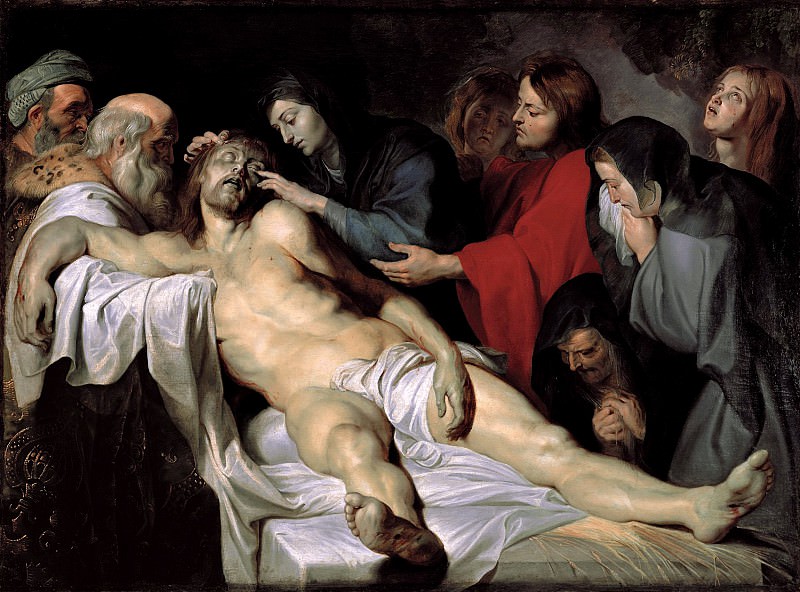Morning Peter Paul Rubens (1577-1640)
Peter Paul Rubens – Morning
Edit attribution
Image taken from other album: gallerix.org/s/95098395/N/1830288583/
Download full size: 2500×1847 px (1,0 Mb)
Painter: Peter Paul Rubens
The brilliant painter, originally from the Netherlands, embodied like no other the vividness and sensuality of Baroque European painting. His artistic legacy encapsulates the Brueghelian laws of realism and the achievements of the Venetian school. Despite the popularity of works of religious subjects and mythological motifs, the artist was a virtuoso in landscape and portraiture. He never hesitated to imitate one of his predecessors, from whom he took his example and used individual elements of the famous Masters in his work.
Description of Peter Rubens’ painting The Mourning of Christ
The brilliant painter, originally from the Netherlands, embodied like no other the vividness and sensuality of Baroque European painting. His artistic legacy encapsulates the Brueghelian laws of realism and the achievements of the Venetian school.
Despite the popularity of works of religious subjects and mythological motifs, the artist was a virtuoso in landscape and portraiture. He never hesitated to imitate one of his predecessors, from whom he took his example and used individual elements of the famous Masters in his work. His formation as an artist was influenced by the works of Titian and Brueghel.
The distinctive characteristics of his paintings are compositional solutions, the richness of the colors used and their shades. But the most important nuances by which one can undoubtedly recognize the work of Rubens are the gestures of the people. They are always wonderfully realistic and painted exactly in the individual artistic style of Rubens.
Boldness and freedom are contained in Rubens’ brushstrokes. He had an artistry of brushwork that sets the artist apart, especially in painting multi-meter compositions.
Rubens painted this canvas while in Italy. In the painting he combined the Virgin Mary’s weeping over Jesus and his position in the tomb. Christ’s unmoving body was already weighted down, his head tipped to the side. He was surrounded by Joseph of Arimathea, John the Evangelist and Mary Magdalene. Very realistically, the artist conveyed their profound experiences. Dense staging of figures creates tension in the picture. It is inherent in the culture of Baroque.
The color solution of the work very subtly and naturally depicts human flesh. Because of the stormy sky and the lighting of only the foreground, there is an acute sense of anxiety, but at the same time, and sublimity of the subject.
Overall, the painting acts as an iconography.
Кому понравилось
Пожалуйста, подождите
На эту операцию может потребоваться несколько секунд.
Информация появится в новом окне,
если открытие новых окон не запрещено в настройках вашего браузера.
You need to login
Для работы с коллекциями – пожалуйста, войдите в аккаунт (open in new window).











![Peter Paul Rubens - The Three Graces [Workshop]](http://cdn.gallerix.asia/j/_EX/754398988/3017.webp)
![Peter Paul Rubens - Drunken Silenus [Manner of]](http://cdn.gallerix.asia/j/_EX/754398988/5880.webp)







You cannot comment Why?
Surrounding the central figure are several individuals, their expressions ranging from grief to quiet contemplation. One woman, positioned prominently near the head, gently touches the man’s face, her gesture conveying tenderness and sorrow. Another figure, clad in a vibrant red garment, leans forward with an air of concern, his hand extended towards the deceased. A bearded man stands at the left edge of the scene, his gaze directed downwards, seemingly lost in thought. Further figures are partially obscured by shadow, contributing to a sense of depth and emotional complexity.
The artist’s use of chiaroscuro – the dramatic contrast between light and dark – is crucial to the paintings impact. It not only directs the viewers attention but also amplifies the atmosphere of solemnity and mourning. The limited color palette, primarily consisting of earth tones punctuated by the red garment, reinforces this mood.
Beyond a straightforward depiction of grief, the work seems to explore themes of sacrifice, compassion, and loss. The exposed body suggests vulnerability and mortality, while the gestures of the surrounding figures underscore the human response to suffering. There is an undercurrent of quiet reverence; it’s not a scene of overt lamentation but rather one of intimate mourning, suggesting a profound emotional connection between those present. The composition invites reflection on themes of faith, empathy, and the enduring power of human connection in the face of tragedy.